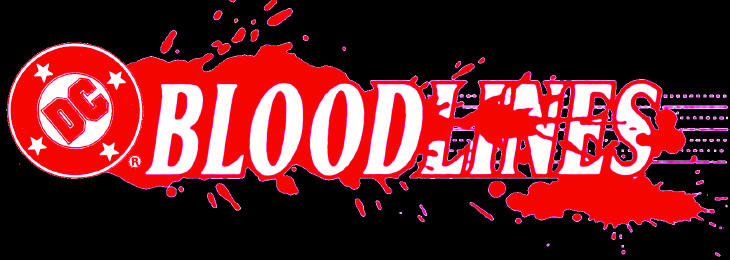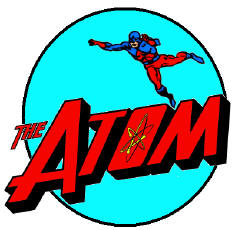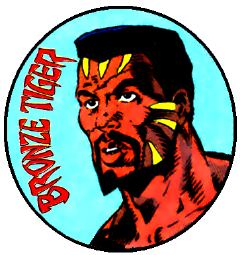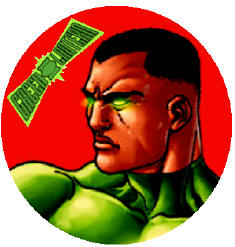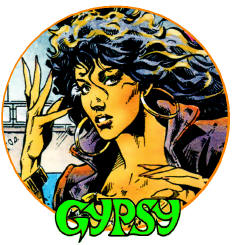Deluxe Comics Wally Wood's T.H.U.N.D.E.R. Agents was like a mid-80s Image Exodus contained in one book. Where else could you get George Perez, Jerry Ordway, Dave Cockrum, Pat Broderick, Keith Giffen, Steve Ditko, Stan Drake, Murphy Anderson, Dan Adkins, and Rich Buckler between two covers? But also like Image, they couldn't get the book out on anything resembling a regular basis, and the Giffen one only lasted five issues. The penultimate issue had a February cover date, and I should point out February of 1986, since the first issue was November of 1984. I don't even think Continuity Comics released that sporadically. I didn't concern myself with that, mind, since I bought the run as back issues nearly a decade after that debut issue. I loved the material so much that it sent me on a back issue buying spree, not just of the Singer material, but everything-- Tower, Archie, that one black & white magazine JCP Features put out with the early Mark Texeira art. The one time I went to San Diego Comic Con, I spent some of my limited funds on low grade Silver Age back issues. And most importantly, to varying degrees I dug all of it, and would go on to follow most T.H.U.N.D.E.R. Agents material going forward.
Hobgoblin was a cool looking villain, plus my brother got the imported Secret Wars action figure as a special from Foley's; Texas' version of Macy's. The combination may have inspired him to buy Amazing Spider-Man #276, the issue with the fake-out reveal that Flash Thompson was the villain.
I'm pretty sure the phrase "I'm liking this Joe Brozowski art" has been used sparingly in human existence, and the Mike Machlan inks certainly helped, but I liked looking at the Fury of Firestorm #47 a lot better than the Blue Devil side of the crossover. I guess it was just more on-model and clean. We're in the last year of Gerry Conway's run, and I don't think this period is especially well regarded, so it's maybe the last entertaining yarn before his checking out. I think for reasons beyond my control, this was the end of my Blue Devil collecting in this time period. I believe my flea market source had simply dried up, although I've mentioned my interest waning as well. I might have gotten one or two more out of cheapie bins, but I specifically recall rejecting the extra-sized $1.25 final issue at a mall bookstore.
I'm not sure how many or which issues of the four-part Legend of Wonder Woman mini-series I flipped through at the mall bookstore. What I do know is that it was a brief Golden Age revival and a stopgap between the Pre- & Post-Crisis ongoing series. Also, I couldn't make heads or tails of the giddy nonsense, and with Misty's Trina Robbins doing an H.G. Peter riff, I wanted nothing to do with it.
Official Handbook of the Marvel Universe Deluxe Edition #6 cover-featured Iron Man, Iceman, and Ka-Zar, indicating a month of Mort to moi. It started things off with a John Byrne Human Torch, but I found only the draw-er to be a draw. Moody Zeck Hydra was more to my liking. The Imperial Guard entry was intriguing to me because of Phoenix: The Untold Story and those Cockrum Legion wardrobe leftovers. Otherwise, there were way too many obscurities and plainclothes folk to hold my interest, and seemingly most of the artists'.
Denys Cowan acquitted himself better on the third Elvira's House of Mystery, a close-up of her blowing smoke out of the barrel of a six-shooter with a cactus in the background. Yes, just as last issue was a transparent ploy to burn off leftover Weird War Tales material, this one is pushing out Weird Western Tales inventory. As I recollect, as with #2, I got this one cheap at Marauder Books in 1989. I have much stronger memories of this one though, probably helped by the Stan Woch art in the bridging sequences that also incorporated her into the first story, by Robert Kanigher and Angel Trinidad Jr. "Ballad of Hanging Rock" had a lot of violence, some near nudity, and a bit of combined sexualized violence besides. Kanigher was, after all, the Sam Peckinpah of comics. On second glance, I spoke too soon about repurposed inventory, as the second Kanigher tale also firmly integrates Elvira, and is a proper horror story involving corrupt global figures taking an elevator to Hell to be tortured in the nude by the devil. It actually isn't much of a story, but Jesus "Jess" Joldloman, another Filipino artist, makes it visually arresting. There's also stronger hints of a subplot, so I figure it for the best issue so far.
G.I. Joe a Real American Hero #47 continued the book's hot streak with the Larry Hama / Rod Whigham / Mike Zeck team, involving tons of action and a lot of action figures being carried around on stretchers. Also, there's a fakeout where Baroness appears to gun down Storm Shadow, and G.I. Joe was the kind of book where that could actually happen.
While still telling founding X-Men puberty stories, at least Brent Anderson's cover to Marvel Saga the Official History of the Marvel Universe #6 kicks it up a notch by threatening to lynch Cyclops and Iceman. Or promising to hang them. I'm good either way. We also get the origin story of creepy ol' Puppet Master, and some Walt Simonson Surter action. Next was my first encounter with Tony Stark's origin story, and I'd forgotten just how much of the first Iron Man tale had made it into that issue. Definitely my introduction to the origin that would eventually launch the MCU.
I want to say my brother or I had a copy of Marvel Tales Starring Spider-Man #187, a reprint of an early Kraven the Hunter story drawn by John Romita, but it didn't exactly etch itself into my brain... unlike the cover to Omega Men #38. You see, they statted that cover into an issue of Son of Ambush Bug when they trapped the villainous Interferer in the last issue of that misbegotten series to end his nuisance. The actual comic means nothing to me, just the bit.
The Punisher #5 of a retroactive five issue run offered another Zeck/Zimmerman cover as part of an iconic series, but the interiors take a substantial downturn. Where #4 clearly ran out of space to tell its story, #5 is just as obviously padded to full length by guest scripter Jo Duffy and new, much worse layout artist Mike Vosberg. I know the trains were more likely to run on time at Jim Shooter's Marvel Comics, but a case can be made for allowing the book to run later and keep the entire bestselling creative team intact. It's actually a solid conclusion, although the forced Don Siegel moral ambiguity doesn't make a ton of sense. There's a bunch of people the Punisher should just be killing, and doesn't, but I liked the bit with the dog.
Secret Origins #2 was another issue to be tossed through at a mall bookstore before getting put back. I'd seen ads featuring Blue Beetle in old Charlton Comics, and he was in the one issue of COIE that I'd read. Like the Gil Kane art, I thought Beetle looked okay, but plainly out of date. The yellow goggles in particular were off-putting, but I also wasn't into the blue-on-blue color scheme with the big bug design on the chest. Finally, the issue really focused on the Golden Age Beetle with a fin on his head, and yeah, no.
Superman #419 was one of those books I'd see in the quarter bin in 1989. It leaned hard into Satanic panic, with the Man of Steel trapped in a pentagram while a Luciferian villain cackled outside its reach. Even Ed Barreto couldn't dump cold water on that heat with his cover, but Curt Swan absolutely ice-bucketed it on the interior. I still wouldn't read that for a quarter.
I'm not 100% certain when I started spending time with my father's family, but if I triangulate via comic book, I'm leaning toward December of 1985. I didn't think we were living in the specific apartment where my half-brother, his half-brother, and a cousin descended upon my bedroom and utterly trashed it in short order, but it makes sense for that to be when I was given a small color television. That would have given enough time for my parents to almost immediately pawn and lose it that spring, and my lie about the color going out without my father having time to determine that we'd actually just replaced it with a second-hand black & white. Also, I had to have enough time to get acquainted with them for it to matter when I moved out of state in 1987, after about nine months of my stepfather soaking up unemployment checks after losing the best job he would ever have to Reaganomics. Plus, the whole reason this show had to switch from a quarterly to monthly format is to account for how many roughly contemporaneous comics were added to my collecting experience by my brother's greater means. Anyway, all this is to say that I did not buy Uncanny X-Men #205, despite a vague sense of having the chance once at my local 7-11. However, the fan favorite Barry Windsor Smith drawn Wolverine solo story that re-introduced Lady Deathstrike and the Reavers was still read by myself at about this time via lil' bro's copy.
The cover to Elfquest #10 is very familiar, but the Hanzel & Gretel style story is not, and ends at an awkward point that makes me think the source for this reprint had more pages to work with. I'm fairly certain that my brother had Star Wars #105, a striking mash-up of Cynthia Martin, Steve Leialoha, and Ken Steacy. However, it was also an issue spotlighting humanoid bugs, dread space pirates, and a slew of pink bunny rabbits. It's no wonder that when I saw Power of the Force figures at Circus World, I wondered why they was still making those, because Star Wars was long over.
Green Lantern #200 had a striking Walt Simonson cover with dozens of corpsmen at the main power battery on Oa, and was featured in a house ad. The interiors spark no memories, and I think I even missed it when I went back to collect much of this run during its COIE tie-in issues. Even if I bothered to toss through this issue at a mall bookstore, I doubt I would have gotten much past all these Silver Age goofus villains drawn by Joe Staton.
Sectaurs #6 continues to look way better than a relative flop of a toy line deserves to, kind of like how the figures themselves were of exceptional quality, but still couldn't connect to an audience. I know the cover and recognize bits of the interiors, but the story was a miss overall.
Another month, another forgettable issue of X-Factor, fourth in a series. I seriously remember Frenzy's OHOTMU entry more than her debut story, and I didn't exactly memorize that either. Ah, the early tales of Artie and Rusty... how little I could care.
Comic Reader Résumé has always been a research heavy show, increasingly so, to the point that some portions are written more than a year in advance. Other portions, though, I only work on right before recording, and my aversion can even cause delays. For instance, the little note that I have to read Star Comics' Meet Misty #4 before progressing, so I read the first, took a nap, and now return for the second. It's a two-page gag showing off Aunt Millie's many '60s hairstyles from her modeling days, Niece Misty making fun of the oddity and effort, and then goes out to a new wave club with Spike, who's got a Cyndi Lauper circa She's So Unusual thing going on. Now, I was still a child with little context for modern fashion, and Trina Robbins was a sort of misfit straight-lace in the '70s underground scene doing a '50s girl comics revival while herself pushing 50. It's hard for me to set aside that now that I'm in the same age range that the writer-artist was then, that the joke she'd been building for two pages was at least two years out of date, and targeting an audience that would be keenly aware of that fact. I don't know if the young girls are still putting a silver rinse in their hair, and I'm pretty sure they're trying to bring lose rise jeans back, because I read millennial women who are warning them not to. Point being, I would have definitely vetted my gag with actual younglings before pulling a howdy-do fellow kids. By the way, the last millennials were born before The Phantom Menace, and are over a quarter-century old, so that reference was nostalgia from their earliest memories, you old.
The first story was about Misty missing her cast party, because a late teens soap opera actress was still expected to babysit. She chastised the twin boys for messing up some of her old and valuable comic books, including issues of Millie the Model and Elfquest, technically a Marvel comic at this point. In lieu of television or video games, Misty told them a story that was a lame mash-up of Cinderella and the Frog Prince, so she clearly couldn't read the room. In the end, her totally straight crush Ricky Martin brought the party to her, including a Billy Active album in place of the actual singer, who was back at the real party. It should be noted that despite being a fake Billy Idol, we hear the true lyrics to the chorus of "Rebel Yell" playing.
I was checking for creator cameos in the credits on the outfits in the stories and among the paper dolls, but the closest I got to recognizable names this time was Martha Thomases, writer of the short-lived and contemporaneous Dakota North series, as well as Barb Rausch, who would go on to write Marvel's Barbie series after assistive work on some well known indies. I was caught off guard by the Shirelle paper doll, because despite a cover appearance, she's not in any of the stories. There are a lot of kid-skewing ads in this issue recognizable to readers from this period, including a sport-themed M&M's illustration, the Spider-Man/Power Pack child sexual abuse PSA, the Challenge of the Go-Bots one where they're bursting out of a TV set, an Earl Norem painting for the Filmation He-Man cartoon, an equal time spot for the She-Ra cartoon, the Oreos trace maze to dunk a cookie in milk IN SPAAACE, the new Crest Pump attending a debut gala, and Madballs. A favorite was the offer of 50 comics adaptations of classic literature for just $14.95, obviously illustrated by a Philipine studio feeling the pinch now that Warren and Red Circle were out of business. Also, there's a bifurcated ad for The Funtastic World of Hanna-Barbera featuring Jetsons cartoons with a new toyetic pet on one side, and Galtar and the Golden Lance on the other. Both were syndication originals, and I doubt either crossed my eyes. Galtar was apparently a naked He-Man lift with a little too much sword & sandals in its DNA, looking more like Ray Harryhausen adventurer in a Blackstar or Thundaar scenario.
Okay, I guess I've put off the third story long enough. As part of the talent contest that got Misty on the soap and launched this comic series, she's also supposed to shoot a fashion spread for Heaventeen Magazine. Aunt Millie also got her modeling start at the same building in New York City, and accompanied Misty. It's decided that they want to do a mother-daughter style spread, and instead of bringing in another model, Misty volunteers her aunt. However, when word gets out that this is the Millie Collins, Misty gets sidelined, and fumes about it. In story, Millie's meant to have been twenty years retired, but for the record, her flagship title didn't end until 1973. Today, it's almost quaint to think a top model would ever look like Anna May Watson when she was surely younger than... well, Trina Robbins, for instance. Once you've managed to balance a daily diet of cocaine, cigarettes, and cucumber water, you either die young or get plastic surgery. You don't just shake off that level of body dysphoria, and we're not talking about some lesser light. Millie the Model was like Heidi Klum crossed with Cindy Crawford, and had more titles than Spider-Man. That's a special breed of cat that still tips paps to catch her doing bikini cartwheels in the sand at sixty, not serving as the Aunt May of a Star Comics teenybopper.
Anyway, Misty internalizes an uncharacteristic, Darlene Dunderbeck-like hissy fit over Aunt Millie hijacking her moment, but when Millie comes back nearly in tears with gratitude over the chance to revisit her heyday, Misty chills and bonds. Despite my grousing, I can see the appeal, especially for me as a Millie/Patsy Walker revival enthusiast. Millie was seriously at the center of an entire Marvel sub-universe of teen humor and romance books that should not be forgotten. But also, just two more to go, thank goodness. Unlike the Punisher, they announced six issues up front, and that's what we got.
I wouldn't have been able to resist flipping through The New Mutants #40 at the 7-11, with that BWS cover of Captain America belting Magneto with his... metal shield? I doubt Butch Guice being inked by Kyle Baker worked for me though, especially on a story featuring the mid-'80s Avengers. It's kind of a wonder that I don't hate Hercules and Sub-Mariner for all the limp appearances of that unit.
Thundercats #4 having the team fall prey to a "Ten Little Indians" scenario is almost cool enough to overcome the family friendly Jim Mooney art. There's even a cool anti-heroine and a baby riff on the Days of Future Past wanted posters.
V #16 came out of the '89 quarter bin, and had a nifty Jerry Bingham cover. Though Tony DeZuniga's inks went a long way toward making Carmine Infantino palatable, the big still came up well short from what I wanted in my comics, V or otherwise. I'll also give a quick shout to Hamster Vice and Ultra Klutz, books that shared space in that quarter bin, but never made it home.
